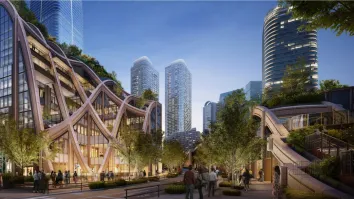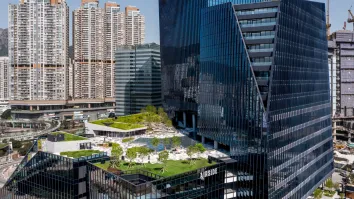
It's back to work in 2021, says CBRE with 70% of bosses wanting a return to the office
The future is collaboration for these new office spaces.
Bosses are increasingly keen for their staff to return to the office, but many offices will need to go through some remodelling as workers look to more collaborative workspaces, says Henry Chin, head of research at CBRE APAC.
Whilst the trend is that companies are now adapting to having more flexible working options post-COVID, CBRE APAC’s conversations with occupiers have shown that a clear majority would like their workforce back in the office.
“We do believe, after talking with Asia Pacific occupiers, that 70% of senior managers in APAC prefer people to be back in the office. As a result, companies will need to rethink their workplace design, and how they plan their workforces,” he said.
When it comes to designing the workplace, Chin said that a more collaborative layout will be more in demand. Referring to solo cubicles as “me” spaces, he said that this old design will have to shift to “we” or shared space.
“In the old days, we all had quite a lot of space for individual cubicles or concentration areas. Going forward, the future of the office is for people to meet, collaborate, brainstorm, and meet your clients,” he said.
“Previously, 50% of our offices were ‘me’ spaces- in other words, cubicles. We are going to see less of ‘me’, and more of ‘we’, so this is something that will cause a huge transformation for the future of office design,” he added.
Lock in now
“If we look at the markets across Asia Pacific, 2021 is still going to be a tenant favored market ” he said.
CBRE APAC said that they advise their tenants to take advantage of the current market condition to expand or make plans before rentals begin to have an uptake and as the market recovers.
“The good news in Asia Pacific is that we are leading global growth and we are better in terms of recovery according to economic projections for 2021,” he said.
“We advise tenants to take advantage of the current market condition to renew, to expand, or to consolidate as 2021 will be a good year. I think that it's going to outperform because of domestic consumption and recovery in global trade,” he added.
Rebound is expected for Sydney, Melbourne, and Shanghai by 2022, whilst Singapore is already seeing rental contractions this year.
“We expect to see the rebound from 2022 onwards particularly for markets in Sydney, Melbourne, and Shanghai. Unfortunately, if you are in Singapore, you are probably already missing the boat because we will see huge rental contractions by this year and we will also see the swing back. So, the rent is going to continue to grow,” he said.
“Based on our latest leasing sentiment survey, we have seen a wider recovery in terms of leasing sentiment in all the major markets, with an increase in leasing inquiries and office site visits. Office-based industries remain relatively healthy in terms of financial status. However, we are expecting to see a wider recovery in the first half of this year. Most occupiers will probably be looking at expansion plans for the second half of 2021,” he said.
Revenge consumption
For hotels and other properties fueled by tourism, he said that improvement may be seen through promoting staycations. Whilst tourism continues to be at a standstill, the short-term outlook will remain the same.
He also noted that outbound investments for Asia are recovering and investors were observed to prefer investing in the APAC region.
“When we talk about the tourism sector, we have to realize that travel restrictions and social distancing measures will continue to weigh down the short-term outlook. But we are seeing revenge staycations in some major markets in the region, so I'm not so bearish,” he said.
“We are starting to see a recovery for Asian outbound investments in the next 12 months. Most Asian investors tell us they want to deploy more capital in the Asia Pacific region,” he added.
As for retail, revenues are projected to be recovered by the second half of the year. The shift to e-commerce is reviving the industry but in the same way it must be ensured that the shopping experience is kept intact.
“We do believe retail, particularly in Asia Pacific, is also here to stay because most Asians love shopping. The shift to e-commerce is fundamentally changing shopping behaviors. As a result, when we talk to retailers, they tell us they are going to redefine their online offerings,” he said.
“In the study we conducted towards the end of last year, 50% of retailers in the region said they want to resume their expansionary plans in 2021. They are predicting the assessed revenue to be back to pre-COVID levels in the second half as well,” he added.
He shared that one retailer said that they are creating a concept of integrating experience in retail even if the shopping is now done online. Customers may adapt to the new trend in shopping by browsing through products online, but they can still go to the physical store to check the items out. This is good for the clothing sector, as some shoppers prefer to fit the items before purchasing them.
“Some landlords are talking about the importance of experience in retail. So, for example, how can I capture the rent based on social impressions? Using technology to capture social impressions, and then translating this into online sales, is still very conceptual as of now. But we will increasingly see retailers embrace new performance metrics and lease formats in the post pandemic era, ” he said.
Flight to quality
Dr. Chin observed that demand for logistics now trumps demand for commercial office spaces. “This is the first time in seven years that we have seen logistics overtake offices as the most preferred asset class. As of now our forecast is a 10% increase in terms of value in 2021.”
For this to work, he said that facilities must be upgraded in logistics space. Technology advancement may also be integrated to meet the needs of companies, especially for those in the tech industry.
“Developers need to start thinking about how to upgrade the supporting facilities in their logistics spaces such as cold rooms and server rooms to cater to the increasing occupier demand on the back of e-commerce surges,” he said.
They also need to think about how they can use technology enhancements to improve efficiencies. Technology and consumer engagement will be more important than ever,” he added.
Dr. Chin also noted that the future of office spaces looks positive, as opposed to what has been reported elsewhere. Based on studies conducted by CBRE APAC, a significant number of companies are looking into expanding their offices instead of closing their doors.
“Occupier sentiment is not as negative as what is often portrayed in the media. Based on our studies, I can tell you that 22% of Asia-Pacific companies say they want to expand their future office spaces,” he said.
The real test will be the flight to quality adaptation of the individual companies, developers, and lessors in offering these spaces.
“I think the flight to quality is top of mind right now. In the old days, landlords only focused on leasing the space and charging rent. But now, if you want to keep a good tenant, you need to look at your office building as a holistic asset, and determine what property management services you are going to offer,” he said.
“They need to make sure those companies are happy, and that these spaces enable people to come back to the office. That is crucially important,” he added.
Photo courtesy of CBRE APAC.


















 Advertise
Advertise


